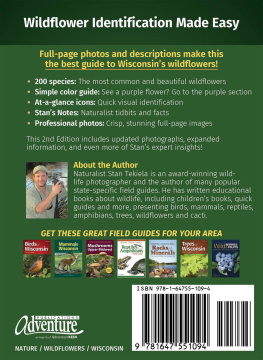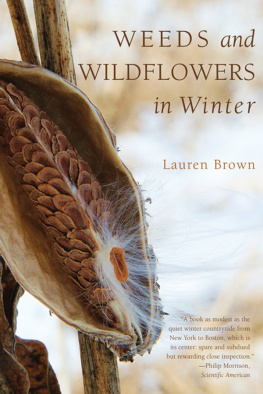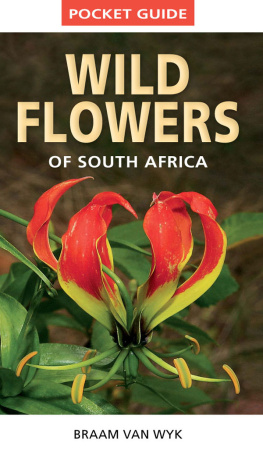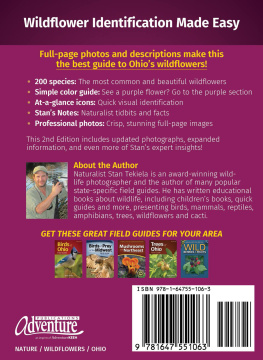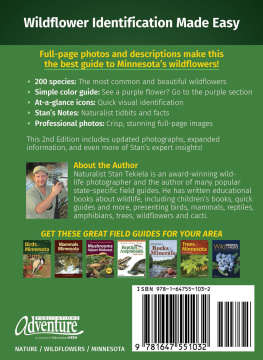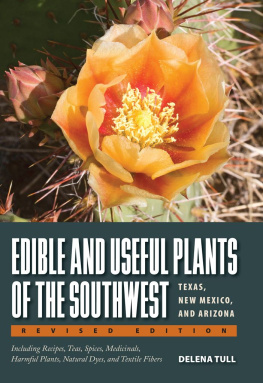
Wildflowers of Houston and Southeast Texas
by John and Gloria Tveten
Photographs by the authors

University of Texas Press
Austin

Copyright 1993 by John L. Tveten and Gloria A. Tveten
All rights reserved
First University of Texas Press edition, 1997
Requests for permission to reproduce material from this work should be sent to Permissions, University of Texas Press, P.O. Box 7819, Austin, TX 78713-7819.
Library of Congress Cataloging-in-Publication Data
Tveten, John L.
[Wild flowers of Houston]
Wildflowers of Houston and Southeast Texas / John & Gloria Tveten; photographs by the authors. 1st University of Texas Press ed.
p. cm.
Originally published: Wild flowers of Houston. Houston, Tex.: Rice University Press, 1993.
Includes bibliographical references (p. ) and index.
ISBN 0-292-78151-2 (pbk.: alk. paper)
1. Wild flowersTexasHouston RegionIdentification. 2. Wild flowersTexasHouston RegionPictorial works. I. Tveten, Gloria A., 1938 II. Title.
[QK155.T84 1977]
582.13097641411dc21
97-3255
ISBN 978-0-292-74948-1 (library e-book)
ISBN 978-0-292-78687-5 (individual e-book)
We dedicate this book to Tuko Darwin Tveten and to the memory of Pearl Olsgard Tveten who taught their children to enjoy the natural world
and toRandell A. Beavers, Larry E. Brown, Charles D. Peterson and the staff of the Robert A. Vines Environmental Science Center who helped us in this project and who open the doors to the world of nature to schoolchildren and adults in our community
ACKNOWLEDGMENTS
We have received the assistance of many individuals and organizations during the preparation of this book. We are particularly indebted to the Robert A. Vines Environmental Science Center and Director Randell Beavers for the use of the Centers herbarium and reference material. Botanists Charles Peterson and Larry Brown aided greatly in identifying numerous specimens collected during the course of our field work.
Many wildflowers were observed and photographed on the grounds of the Houston Arboretum and Nature Center, the Mercer Arboretum and Botanic Gardens, the Armand Bayou Nature Center, and the Houston Audubon Societys Edith L. Moore Nature Sanctuary. We thank them for their help in this project and for their continuing efforts in nature education and conservation so vital to the preservation of our native plants and animals.
Gary Freeborg, Doug Williams, and Bob Honig provided valuable information on local plants and aided us in finding several species, while Martha Henschen and Jim Powell of The Chickadee Nature Store have been a constant source of information on botanical and wildflower literature.
We offer special thanks to editors Susan Fernandez and Susan Bielstein and the staff of Rice University Press, who believed in this book and worked so patiently with us.
Finally, we are indebted to the Houston Museum of Natural Science for the financial backing necessary to include color photographs of so large a selection of Houstons beautiful and fascinating wildflowers.
INTRODUCTION
This guide is intended for a broad audience without botanical training. We have kept the use of technical terms to a minimum, defining those that have no common counterpart in everyday language. We believe that the brief descriptions, along with the color photographs, will enable the interested observer to identify most of the wildflowers that occur in the immediate Houston area.
No book of this scope, of course, can treat all the flowers that might be encountered, but this one has the advantage of focusing on a limited area. Most of the available wildflower books treat the entire state or a large region of it, and the options are even more numerous. The 210 species included here were selected as representative of Houston flora and the various families found along area roadsides, in vacant lots, and even as weeds in urban lawns and gardens. Where several similar species occur, one may need to consult more technical manuals. However, most readers will be content to identify such confusing plants to the genus level. In those cases, the most abundant of the closely related species have been selected for inclusion in this book.
Species accounts are arranged by color: white, yellow, red/pink, blue/violet, and green/brown. It is not always possible to draw distinct boundaries between these color groups, particularly in the case of the purplish flowers. For them, the reader will want to compare a plant with the pictures and descriptions in both the red/pink and blue/violet sections. Individual flowers may also vary in color within a species. For example, some plants have blossoms ranging from white to pale pink or blue. In spite of the problems in classifying flowers by color, most beginning enthusiasts will find the system easier to use than a classification by family.
We have kept botanical descriptions to a minimum within the accounts and have included other information on such topics as folklore, the edibility or poisonous properties of the plants, medicinal uses, and the sources of their common and scientific names. The reader may also wish to consult the preliminary summaries of the various plant families in order to place species in a broader context.
All photographs were taken in their natural settings by the authors. However, we frequently used an electronic flash in order to obtain the sharpness and depth of field necessary to portray the flowers in detail. Too often, dim light and brisk winds make photography by natural light all but impossible, and we have placed a premium on photos useful for identification.
NOMENCLATURE
Both the common and scientific names are given for each species, as well as the common and scientific names of its family. While the Latinized names may at first seem intimidating, they provide the only means for positive identification. We have attempted to select the common name most frequently used, consistent with good nomenclatural procedure; however, many of our wildflowers travel under a host of colloquial names. These are listed as alternate names for each species and are included in the index to aid in finding a particular flower.
Various references differ in the use of hyphens in common names. One book, for example, may call our common pink spring flower an evening primrose, while another hyphenates the name to evening-primrose. We prefer the latter form, because flowers of this family are not true primroses; they belong, instead, to a distinct family of the evening-primroses. Usually we have employed the hyphenated names, which are the bane of editors but which help to refine an inexact nomenclature.
In scientific usage, the name of each plant is written as a binomial: Oenothera speciosa, for example, to designate our showy evening-primrose. Such names are italicized, and the first part, the genus, is capitalized. Plants in the same genus are more closely related to each other than to those in other genera within the same family. Subspecies or varieties within a single species are accorded an additional term.
Although each scientific name should be unique to a particular species, taxonomy changes continually as botanists clarify relationships among our myriad plants. Thus, books and checklists may use different names in reference to the same plant, depending on the time of their publication and the authority they chose to follow. Even scientists disagree at times.
Next page

